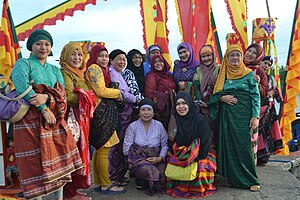Maguindanao people
The Maguindanaon people are an Austronesian ethnic group from the Philippines. The Maguindanaon are part of wider political identity of Muslims known as Moro, who constitute the third largest ethnic group of Mindanao, Sulu and Palawan. The Maguindanaons constitute the ninth largest Filipino ethnic group and are known for being distinguished in the realm of visual art. They have been renowned as metalworkers, producing the wavy-bladed keris ceremonial swords and other weapons, as well as gongs. The Maguindanaons historically had an independent sultanate known as the Sultanate of Maguindanao which comprises modern day Maguindanao del Norte, Maguindanao del Sur, Zamboanga Peninsula, Davao Region and Soccsksargen. The name "Maguindanao/Magindanaw" itself was corrupted by Spanish sources into "Mindanao", which became the name for the entire island of Mindanao and its surrounding islets.[3]
Magindanawn مڬندنون | |
|---|---|
 Maguindanaon women at S.K Festival. | |
| Total population | |
| 2,021,099 (2020 census)[1] (1.9% of the Philippine population) | |
| Regions with significant populations | |
(Bangsamoro, Soccsksargen, Zamboanga Peninsula, Davao Region, Manila, Cebu) | |
| Maguindanao del Norte and Maguindanao del Sur | 1,101,885[2] |
| Sultan Kudarat | 243,445[2] |
| North Cotabato | 214,015[2] |
| South Cotabato | 41,721[2] |
| Sarangani | 41,516[2] |
| Zamboanga del Sur | 41,255[2] |
| General Santos City | 40,073[2] |
| Metro Manila | 38,861[2] |
| Zamboanga Sibugay | 12,910[2] |
| Bukidnon | 10,709[2] |
| Davao City | 8,258[2] |
| Zamboanga del Norte | 4,030[2] |
| Rizal | 3,168[2] |
| Cavite | 2,816[2] |
| Davao del Norte | 2,658[2] |
| Languages | |
| Native Maguindanaon Also Filipino • English | |
| Religion | |
| Sunni Islam | |
| Related ethnic groups | |
| Maranao, Iranun, Kalagan, Lumad, Sama-Bajau, other Moro peoples, Visayans, other Filipinos, Malay people other Austronesian peoples | |
Etymology
The word Maguindanao or Magindanaw means "people of the flood plains", from the word Magi'inged that means "people or citizen" and danaw that means "lake or marsh". Thus Maguindanao or Magindanaw can also be translated as "people of the lake", identical to their close neighbors, the Maranao and Iranun. These three groups speak related languages belonging to the Danao language family.[4][3]
Language
The Maguindanao language is the native language of the Maguindanaons.[5] Aside from this, most are able to speak Filipino[6], and English in varying levels of fluency. Arabic is also used among madrasah-educated Maguindanaons, being the liturgical language of Islam, a religion of most Maguindanaons, though it is rarely used beyond its religious environment except by Maguindanaons in the Middle East, especially in Saudi Arabia, who are fluent in that language.
Musical and performing arts
The Maguindanaon have a culture that revolves around kulintang music, a specific type of gong music, found among both Muslim and non-Muslim groups of the Southern Philippines.
Maguindanao People Media
The Sultan Kudarat monument at Tantawan Park. He is one of the most powerful rulers of the Sultanate of Maguindanao. During his reign, he successfully fought against the Spanish invasions and prevented the spread of Christianity in his controlled territories in Mindanao in the 17th century.
Maguindanaon girls dancing in Cotabato City, Mindanao (1913).
A Maguindanaon dance performed during the T'nalak Festival in Koronadal, South Cotabato.
References
- ↑ "Ethnicity in the Philippines (2020 Census of Population and Housing)". Philippine Statistics Authority. Retrieved July 4, 2023.
- ↑ 2.00 2.01 2.02 2.03 2.04 2.05 2.06 2.07 2.08 2.09 2.10 2.11 2.12 2.13 2.14 "2020 Census of Population and Housing". Philippine Statistics Authority. 2020.
- ↑ 3.0 3.1 Campbell, Gwyn (2018). Bondage and the Environment in the Indian Ocean World. Springer. p. 84. ISBN 9783319700281.
- ↑ Baradas, David B. (1968). "Some Implications of the Okir Motif in Lanao and Sulu Art" (PDF). Asian Studies. 6 (2): 129–168. S2CID 27892222. Archived from the original (PDF) on January 29, 2019.
- ↑ "A grammar of the Maguindanao tongue according to the manner of speaking it in the interior and on the south coast of the island of Mindanao". Washington, Govt. print. off. 1906.
- ↑ The Filipino Language: A Comprehensive Overview | Dynamic Language
